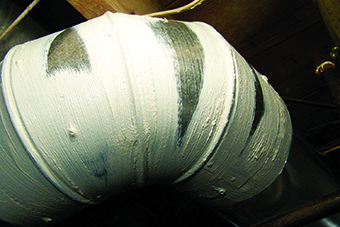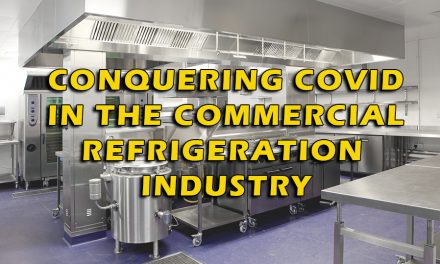
Dominick Guarino
If you read Part One of this series in the July issue, maybe this concept of High-Performance Contracting sounds interesting. ‘But what’s in it for me?’ should be the next question on your mind. Maybe you already run a pretty good business. You’re making a living and your customers seem fairly happy ‘ at least you’re not getting too many complaints. So why change? Why should you make such a radical and possibly disruptive change in your business?
There are many reasons to become Performance-Based, one being that most businesses strive to differentiate themselves from their competition. Let’s look at some of the reasons to make the leap:
Are You Happy with Your Net Pro’ts?
For decades, the average net profit for HVAC contractors hovered around 2-3%. Most business consultants and coaches say that to ‘nance your business into the next year you need to reinvest 5% of your revenues into things like vehicles, tools, computers, etc. If your net pro’t is 2%, where will that additional 3% come from? Will you borrow it, putting your company deeper into debt, hoping that eventually you’ll get caught up?
To maintain a successful HVAC business your minimum net profit goal should be 10% EBITDA (Earnings Before Taxes, Depreciation, and Amortization). This number should be after you’ve paid yourself and your partners a fair salary. If you rely on net profit to supplement your income, then it’s not real net profit, and you will not be able to build up the financial cushion and assets to help you weather the inevitable ups and downs of business.
The good news is whether your net pro’t is 2% or 9%, the work created through selling high-performance HVAC can bring your companywide net pro’ts well into the mid double-digit range. How? By adding high margin work with virtually no competition for both installation sales and service/maintenance.
 Minimum Ef’ciency Standards Will Further Commoditize Our Industry
Minimum Ef’ciency Standards Will Further Commoditize Our Industry
The ever-increasing minimum equipment efficiency standards are fast reducing our ability to ‘sell up’ using traditional ROI (Return on Investment) arguments, which the industry has hung its hat on over the past two decades. When you compare the cost difference between a 14-SEER unit and a 20-SEER unit to the annual energy savings, you’ll ‘nd very meager results with payback periods of 15 years or more. This won’t exactly excite customers about the money they supposedly save by buying the more ef’cient unit.
The kicker is unless the air distribution system is renovated, and the coil is replaced along with the condensing unit, the new 18-SEER unit may only perform at 12 SEER or less! In some cases, your customer will see increased utility bills, unless you properly address the whole system. More on this later.
Differentiation
Most industry consultants stress the importance of differentiation. They say if you’re not different enough, the customer resorts to comparing price. I completely agree. But that is usually where our agreement ends. Why? Many coaches and consultants will tell you the way to differentiate is to sell up to higher ef’ciency boxes and offer all kinds of accessories to increase the average ticket price.
While there’s nothing wrong with providing accessories and selling up, these things should be part of an actual solution, not just a bunch of add-ons to bring the ticket price up. The same holds true with ‘warm fuzzies,’ like wearing booties and laying drop cloths. These things are now expected, they don’t make you much different than your competitor down the street.
So, what can you do to truly differentiate yourself? Let’s start with the selling process.
Performance-Based Selling
This type of sales call barely resembles the traditional sales process. It begins with asking comfort questions when setting up the appointment. It involves using diagnostic tools like airflow hoods, manometers to measure static pressures, and digital hygrometers to measure enthalpies. Most importantly, it involves educating your customer about their home comfort system. You can help them become more knowledgeable than your competition ‘ without making their eyes glaze over with a bunch of technical terms.
A Performance-Based salesperson rarely resorts to the traditional ‘closing’ techniques that are widely used in our industry. Instead, he educates customers through the buying process, making his company and solutions the best choice. People want to make their own decisions based on their knowledge. The Performance-Based selling process provides them that knowledge, backed up with documentation.
High-Performance contractors can dismiss most of the competition with this approach. Not only are you very different from your competitors, you have the measured, documented results to back it up. If a customer says, ‘well no one else said there was a problem with my ducts,’ you can show them your reports documenting how their system is working ‘ or not. Then you ask them if anyone else provided them with a similar report. Usually this puts any doubts about you to rest, and it raises serious concerns about the competence of the other guy.
Re-energize Your Employees
Another bene’t of becoming Performance-Based is employee growth opportunities’ particularly for ‘eld personnel. Most technicians worth their salt strive to stay on top of their game and want to learn the most current diagnostic and repair techniques. Many companies ‘nd themselves in a rut. Often there is little spark left. It’s the same-old, same-old, every day.
Performance-Based Contracting can breathe new life into a company. I’ve seen owners, sales people, technicians, and installers come to life with the new culture built into a Performance-Based business. It’s not unusual to see 20-30- year industry veterans get excited about their industry again.
 Will You Lead or Follow?
Will You Lead or Follow?
In recent years, we’ve seen both federal and local governments cracking down on poor installations. Some states passed legislation allowing building inspectors to demand air balance
reports on residential installations.
We all know how for years the Department of Energy (DOE) stressed equipment ef’ciency. But now with higher minimum equipment efficiency standards in place, they’re shifting their focus to the duct system. They ‘nally ‘gured out that most performance and energy is lost through poor distribution systems.
Until recently, most government agencies, along with utilities and ‘Energy Crusaders,’ focused on tight ducts alone to make systems more ef’cient. It’s taken some years for them to accept what some of us have said all along: Tight ducts alone don’t provide ef’cient system performance. Unfortunately, many still don’t get it.
In fact, because there are so many undersized duct systems out there, just sealing ducts can choke down the system. This can compromise performance, comfort, and ef’ciency. Duct sealing alone might cause safety issues by creating pressure imbalances that can cause ‘ues to spill and produce deadly carbon monoxide.
 Tight ducts are only a slice of the system performance pie. It’s impossible to assure consumers’ energy ef’ciency based on sealed ducts alone. Again, there’s nothing wrong with sealing ductwork. It’s part of any good duct renovation. But before we seal, we must make sure the ducts are big enough to handle the needed air’ows.
Tight ducts are only a slice of the system performance pie. It’s impossible to assure consumers’ energy ef’ciency based on sealed ducts alone. Again, there’s nothing wrong with sealing ductwork. It’s part of any good duct renovation. But before we seal, we must make sure the ducts are big enough to handle the needed air’ows.
A Grass Roots Movement
Parallel to government intervention is the growing movement among quality contractors to take their companies to the next level with delivered performance. I think this is very powerful. The National Comfort Institute alone has trained and certi’ed nearly 30,000 professionals in more than 7,000 companies in air diagnostics, system performance testing, and air balancing. Many have embraced this approach as their new way of doing business.
The handwriting is on the wall ‘ look around you when you attend meetings and association conferences. The movement is towards measured, documented performance. It just makes sense. It’s what this industry should have been doing all along, but it lost its focus with all the attention on equipment alone.
While it’s important to sell high quality equipment, your focus with your customer needs to be on how that equipment will perform in their home. Remember, customers don’t ‘want’ furnaces and air conditioners, they want the comfort these appliances provide. And they want it as safe, ef’cient, and reliable as possible. Measured performance allows you to deliver on that promise.
There are many other bene’ts to transforming your company into a Performance-Based business. Your thorough and unique approach will generate referral business. You’ll also likely get their service business with long-term maintenance agreements. After all, who else can they trust their ‘nely tuned high-performance system to?
In the next article in this series we will examine the 10 steps successful contractors have taken to implement High Performance in their contracting businesses.












Recent Comments